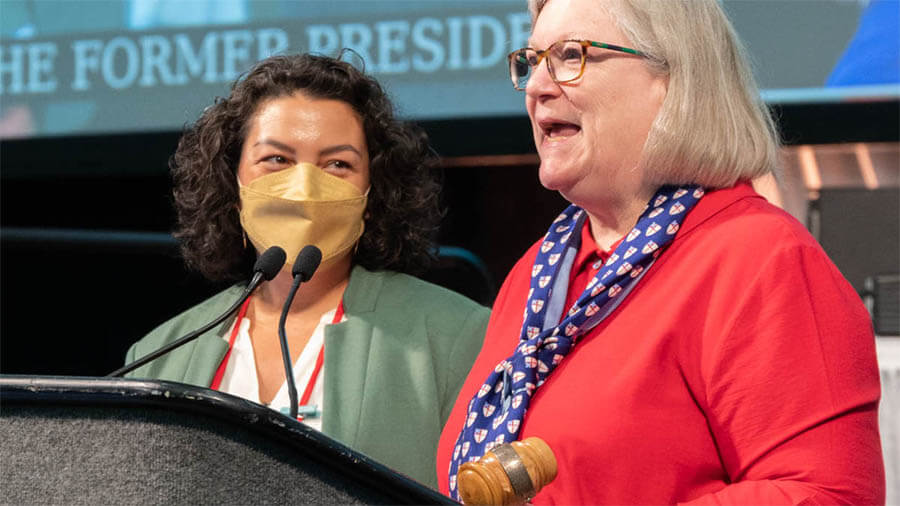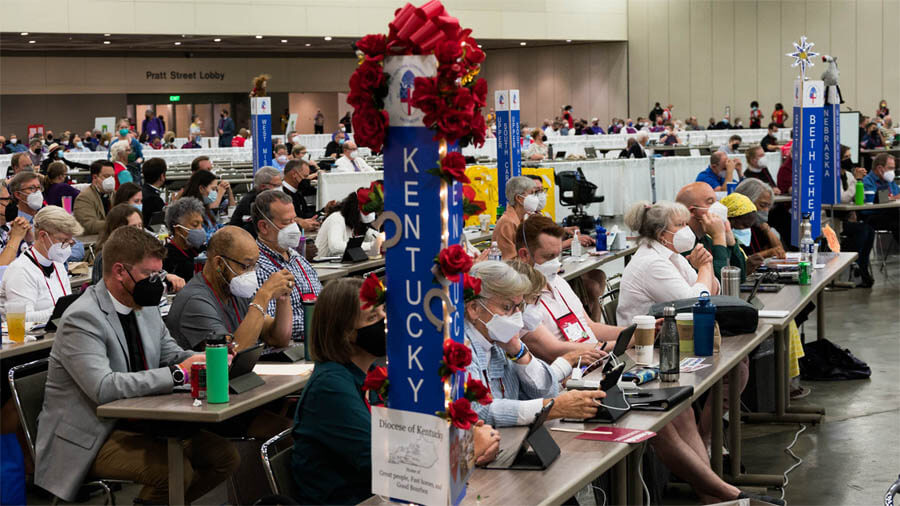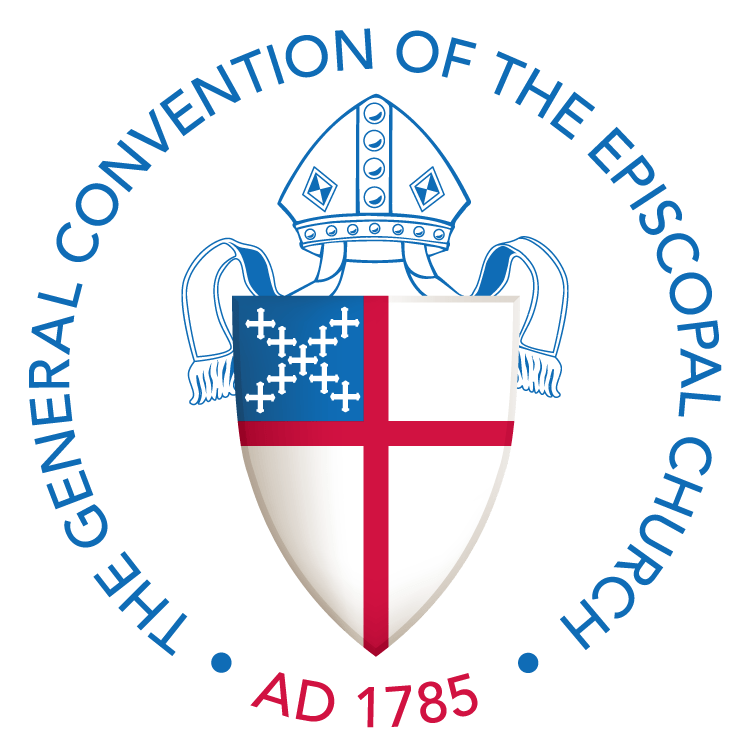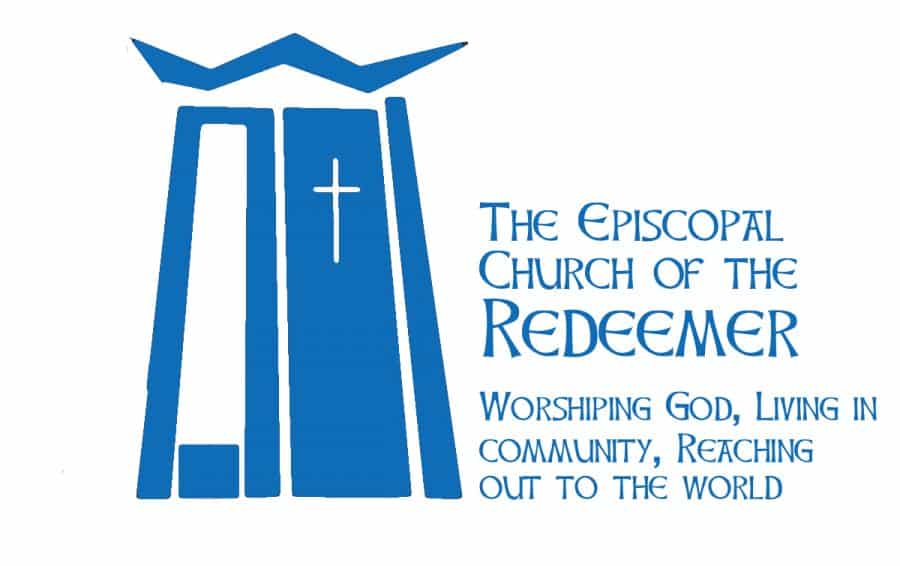[Episcopal News Service – Baltimore, Maryland] The 80th General Convention of The Episcopal Church is one for the history books, and not just for the decisions made but also for how the COVID-19 pandemic changed the way the church conducted its business.
The July 8-11, 2022, gathering – postponed a year because of COVID-19 and shortened from eight days – conducted what Presiding Bishop Michael Curry had referred to during the planning process as “matters essential for the governance and good order of the church.” Still, 412 resolutions were filed for consideration.
Legislative committees acted online most of the resolutions before gathering in Baltimore. That cleared the way for the House of Bishops and House of Deputies to devote the in-person gathering only to legislative floor sessions. They passed most of the resolutions in batches through consent calendars. Bishops and deputies had floor debates only on more controversial measures or on actions that they wanted to raise to greater prominence.
The streamlined convention had been scheduled to run until 5 p.m. EDT but both houses finished their work before 1 p.m. on July 11.
Actions at General Convention
Among those essential actions the bishops and deputies did were the following:
- Passed a $100.5 million budget for the next biennium. The 81st General Convention is scheduled for the summer of 2024.
- Approved the first reading of a constitutional change to clearly define the Book of Common Prayer.
- Continued the church’s commitment to reckoning with it history of racism.
- Elected Julia Ayala Harris to succeed the Rev. Gay Clark Jennings as House of Deputies president and the Rev. Rachel Taber-Hamilton as vice president.
- Agreed to the reunification of two dioceses in Texas.
COVID-19
COVID-19 hovered over the gathering. About 1,200 attended; typically, as many as 10,000 people participate. They had to provide proof of vaccination and conduct rapid tests in their hotel rooms each morning. Attendees and volunteers also were asked to report positive tests to Dr. Rodney Coldren. All participants received five test kits the day they registered at the Baltimore Convention Center. They had to wear masks indoors. There was no exhibit hall, a space typically filled with displays from vendors and Episcopal-related ministries. No visitors were allowed.
There were 32 reported COVID-19 infections at General Convention through the afternoon of July 12, according to Dr. Rodney Coldren.
Twenty-five deputies (including one the morning of July 12), two bishops, two spouses, two staff and one volunteer reported positive self-tests, Coldren told Episcopal News Service on July 12
Twelve of those cases were new between Coldren’s reports to the House of Deputies on July 10 and 11.
“COVID-19 is doing exactly what it does: it multiplies,” he told the House of Deputies the morning of July 11. “We’ve gone from an average of five a day to seven to 12. This is exactly what it does.” He added that he expected more convention participants to test positive on July 12.
Coldren said his July 11 briefing that using a conservative model, he would have expected 76 cases, or about 10 percent, in their house had convention not been shortened to four days and had protective measures such as masking and daily self-testing not been taken. His modeling assumed no major outbreaks within any deputation but, rather, one-to-one transmission every other day, he said.
“Know that what you have done really has protected your fellow deputies,” he said.
Coldren warned participants to be vigilant up to five days from the end of convention. He urged them to be masked when in public during that time.
$100.5 million churchwide budget adopted, future budget process revised
The convention adopted a balanced $100.5 million churchwide budget. Much of the new spending in the budget is tied to resolutions proposed by the Presiding Officers’ Working Group on Truth-Telling, Reckoning and Healing. Central among them is Resolution A125, for which the budget includes $400,000 in start-up funds for a new Episcopal Coalition for Racial Equity and Justice.
The budget plan, as proposed by the Joint Standing Committee on Program, Budget and Finance, includes spending $225,000 on research to confront The Episcopal Church’s historic ties to the federal system of Indigenous boarding schools, as outlined in Resolution A127.
Convention changed the budget process itself. Resolution A048 eliminates Program, Budget and Finance and instead empowers Executive Council to present its budget proposal directly to General Convention through a standing budget committee.
The reforms are meant to streamline the process, ending the expectation that Executive Council spend two-and-a-half years producing a budget draft only to hand it over to Program, Budget and Finance to get up to speed and finalize a budget to propose to convention.
The change also should make it easier to accommodate the funding requests of General Convention resolutions. “The new budget committee will meet again [after General Convention], and they will look at every resolution that’s passed by this body and try to figure how to fund them as best is possible,” the Rev. Mike Ehmer, Northwest Texas deputy and Program, Budget and Finance chair told the convention.
View the narrative version of the budget.
Full ENS coverage of the budget process is available here.
Defining the Book of Common Prayer — it might not be just a physical book anymore
Convention approved the first reading of a constitutional change to define the Book of Common Prayer. Resolution A059 calls for amending Article X of the Constitution of The Episcopal Church, which lays out how the Book of Common Prayer can be revised but has never specifically provided for authorized liturgies that are not proposed revisions to the existing book.
If the change passes a second reading at the 81st General Convention in 2024, Article X would, for the first time, define the Book of Common Prayer as “those liturgical forms and other texts authorized by the General Convention.” In other words, liturgies that are not in the current prayer book – such as same-sex marriage rites and gender-expansive liturgies – could be elevated to “prayer book status,” whether they are replacing parts of the prayer book or standing on their own.
Over a dozen liturgical texts have been “authorized” – for trial use, experimental use, or simply “made available” – by General Convention over the years. However, Article X currently only addresses convention’s ability to revise all or some of the existing Book of Common Prayer. It says nothing about the authorization of other liturgies not directly related to the existing prayer book, a category that encompasses many of the other rites.
All authorized Episcopal liturgies are compiled at episcopalcommonprayer.org, which was created by the Task Force on Liturgical and Prayer Book Revision. Resolution A058 designated the site as the official liturgical website of The Episcopal Church.
Read Convention passes measure broadening definition of Book of Common Prayer.
Full ENS coverage of prayer book and liturgical revision is available at Prayer Book Revision.
Reckoning with church’s systemic racism and involvement in Indigenous boarding schools
Perhaps some of the most moving debate during the convention came as bishops and deputies considered Resolution A125 to establish a voluntary Episcopal Coalition for Racial Equity and Justice among dioceses and congregations, and Resolution A127 to pledge more than $2.5 million over the next biennium to further The Episcopal Church’s commitment to investigating its role in Indigenous boarding schools.
House of Deputies President the Rev. Gay Clark Jennings called it “holy listening.”
Read the ENS coverage of the deputies’ consideration of both resolutions and the bishops’ actions.
Convention passed two other resolutions related to racism. Resolution A086 would allocate money toward making a priority the development and support of programs that respond to eco-justice concerns, address environmental racism, and work to alleviate environmental burdens on Indigenous communities, and to provide training and financial aid and other resources for the work. Resolution A052 clarifies the mandate of the Executive Council Committee on Anti-Racism and Reconciliation. Resolution C058 requires the Executive Council to respond to the church’s racial audit of leadership.
Bishop Eugene Sutton of the hosting Diocese of Maryland preached about The Episcopal Church’s legacy of racism during his sermon on July 10.

Historic election for House of Deputies leaders
Two women will lead the House of Deputies for the first time in history. Oklahoma lay Deputy Julie Ayala Harris, elected July 9 on the third ballot, succeeds the Rev. Gay Clark Jennings, who finished her third and canonically required final term at the end of convention.
Ayala Harris is the first Latina and the youngest person elected to lead the house.
Deputies elected the Rev. Rachel Taber-Hamilton as vice president the following day. Taber-Hamilton, who is Shackan First Nation, is the first Indigenous and first ordained woman to serve as vice president.
Ayala Harris and Taber-Hamilton are the first people of color serving together as leaders of the House of Deputies.
Full ENS coverage is at Self-proclaimed ‘church geek’ Julia Ayala Harris elected House of Deputies president and House of Deputies elects Rachel Taber-Hamilton vice president.
Reunion of two Texas dioceses
The Episcopal Church in North Texas now has a new identity as part of the Diocese of Texas.
Resolution D050 reunified the Fort Worth-based Diocese of North Texas with the Diocese of Texas.
The North Texas diocese, with 14 congregations and fewer than 4,000 members, was greatly diminished in membership by a 2008 schism, in which a majority of clergy and lay leaders in the Episcopal Diocese of Fort Worth voted to leave The Episcopal Church over disagreements about the ordination of women and LGBTQ+ people.
The merger followed a process known as reunion since both dioceses have roots in the historic Diocese of Texas. Convention’s vote follows actions in June by the diocesan conventions of each of the two dioceses to approve the merger.
Read full ENS coverage at General Convention approves North Texas, Texas reunion as one of its final actions in Baltimore.
Social justice actions
While some Episcopalians worried ahead of time that the shortened convention would limit action on social justice issues, bishops and deputies took stands on several such issues.
Reproductive rights, including abortion access
Convention passed Resolution D083 “affirming that all Episcopalians should be able to access abortion services and birth control with no restriction on movement, autonomy, type, or timing.” After impassioned debate, deputies rejected Resolution D054, which asked church leaders to consider relocating the 81st General Convention from Louisville, Kentucky, and all future meetings of convention to venues where women and others able to conceive, bear and birth children have full access to reproductive health care. That rejection meant the resolution did not go to bishops.
Bishop and deputies amended Resolution A001, setting the five finalists for the 82nd General Convention in 2027, requiring church leaders to “consider the physical and emotional well-being and safety” of attendees when picking a site.
Read full ENS coverage, including the five location finalists, at States’ anti-abortion laws fuel impassioned debate by deputies over future General Convention sites.
Family leave polices
Convention adopted resolutions to offer paid family leave and health insurance to lay and clergy church employees through the Denominational Health Plan. Resolution A003 urges but does not require, dioceses to adopt uniform paid family leave policies for all employees. Resolution D034 created a new task force to provide advice about the Denominational Health Plan, which is provided through Church Pension Group and which churches and dioceses are required to provide to clergy and some lay employees. The task force will provide the 81st General Convention in 2024 with options to reduce health insurance costs across The Episcopal Church.
Read full ENS coverage at Bishops concur with deputies encouraging adoption of paid family leave, health insurance for lay and clergy church employees.
Gun violence epidemic
Convention spoke out against gun violence, passing resolutions B003 on ghost guns, B006 urging advocacy for state legislation against gun violence and B007 commending investment in community violence intervention to prevent gun violence.
Participants rallied in prayer when gun violence struck close to the Baltimore Convention Center the afternoon before convention began.
Convention rose in unanimous, silent affirmation of Resolution A226, to recognize, honor and lament the three members of St. Stephen’s Episcopal Church in Vestavia Hills, Alabama, who were murdered June 16 by a man who was attending a potluck supper at the church. The resolution also recognized the surviving 18 church members and friends who were there that night. ENS coverage is at General Convention honors victims, recognizes survivors of the Alabama church shooting.
On the lighter side
Will the last deputy …
Prior to convention, Coldren, the public health expert hired to advise Jennings with $50,000 approved by Executive Council, suggested during a briefing for deputies that deputations designate one member to not participate in group activities, such as dining together, to preserve their diocese’s vote should all deputation members be infected with COVID.
Of course, GC80 Designated Survivor immediately began tweeting.
The term quickly gained traction. Jennings adopted it as the title for the deputy appointed at every convention to preside over the house if both the president and vice president cannot. The Very Rev. Sam Candler, chair of the Atlanta deputation, held that title for the 80th General Convention but did not have to serve.
Please refresh your device
The 80th General Convention was often stymied by lack of dependable and continuing WiFi access. Systems failed in both the House of Bishops and House of Deputies on the opening day, preventing participants from accessing the internet on their church-provided iPads, and forcing the bishops and deputies to temporarily postpone votes that required digital tallies. WiFi trouble continued off and on in the House of Deputies up until the final gavel, especially during elections. The difficulties prompted widespread tweeting.
The text of all resolutions and their final status are in the General Convention Office’s Virtual Binder at vbinder.net.
Read the full ENS coverage of the historic convention and events leading to it.

Onward to Kentucky
The next stop for the General Convention is Louisville, Kentucky, in the summer of 2024.
—The Rev. Mary Frances Schjonberg retired in July 2019 as senior editor and reporter for Episcopal News Service.

What happens at General Convention?
The legislative process of General Convention is an expression of The Episcopal Church’s belief that, under God, the Church is ordered and governed by its people: laity, deacons, priests, and bishops.
The General Convention is the Church’s highest temporal authority. As such, it has the following power:
- Amend the Constitution and Canons of the Episcopal Church
- Amend the Book of Common Prayer and to authorize other liturgical texts
- Adopt the budget for the Church
- Create covenants and official relationships with other branches of the Church
- Determine requirements for its clergy and other leaders
- Elect its officers, members of the Executive Council, and certain other groups
- Delegate responsibilities to the Interim Bodies of The Episcopal Church
- Carry out various other responsibilities and authority

Church of the Redeemer
Church of the Redeemer: Worshiping God, living in community, and reaching out to the world around us. We are an Episcopal Church serving north King County and south Snohomish County. We welcome you be with us as we walk the way of Jesus.
Church of the Redeemer is at 6210 Northeast 181st Street in Kenmore, Washington. We are a short distance north of Bothell Way, near the Burke-Gilman Trail. The entrance looks like a gravel driveway. The campus is larger on the inside than it is on the outside. And we managed to hide a large building on the side of a hill that is not easily seen from the street.
The Episcopal Church welcomes you.






